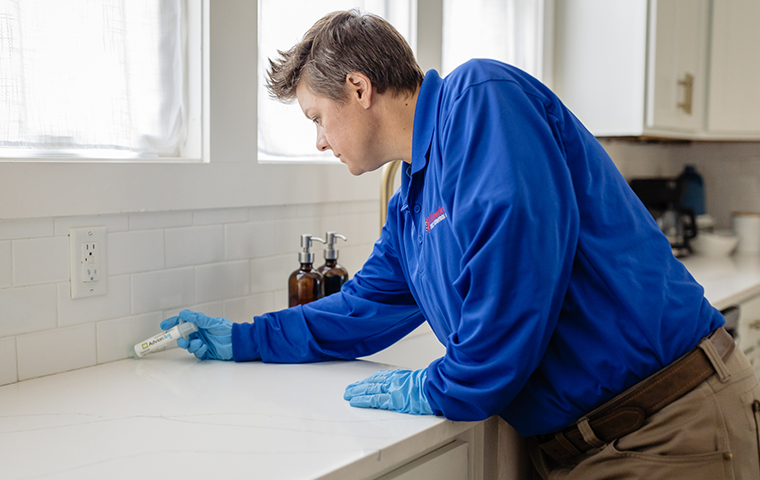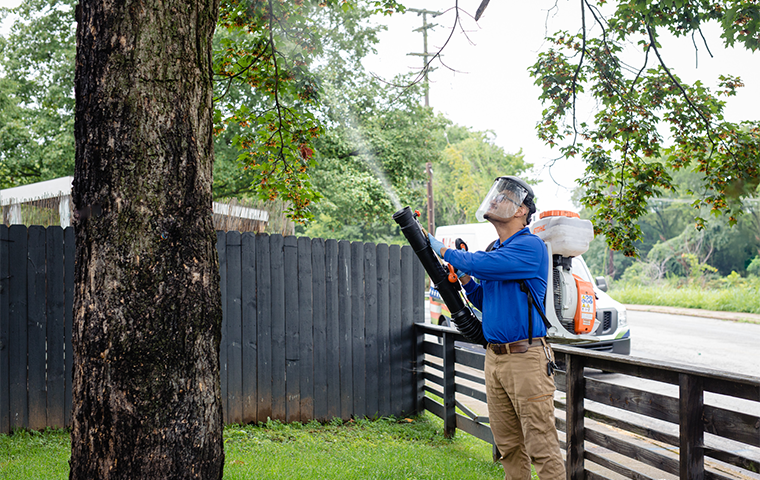Subterranean termites are sneaky pests, and we don't want them to sneak up on you. That's why we've put together this quick and comprehensive guide to termite control in Mt. Juliet. We'll discuss why termite swarms are often the first warning sign of a termite infestation in Mt. Juliet and what it means to see a termite swarm in your home or on your property. We'll look at a few all-natural ways you may avoid termite damage and end by talking about the innovative way All-American Pest Control deals with these sneaky, wood-damaging pests.
Before we get started, we want to remind you; help is available if you need immediate assistance. Our knowledgeable service professionals can answer your questions and direct you toward a solution that works for you. If you'd like to speak with someone directly about your termite concerns, we're here to help. Jump to our contact page for industry-leading termite pest control in Mt. Juliet.

Flying Termites Could Be The First Warning Sign
Termite colonies have a caste system. The queen and the king rule. Around them are reproductive termites, which help with caring for offspring. The workers are sent out on a mission to gather food. The soldiers protect the workers. Once the colony grows large enough, something miraculous happens: some reproductives grow wings. These flying termites (referred to as swarmers because they gather into a swarm during the mating process) leave the colony on a mission to create more colonies.
Knowing what a termite swarmer looks like is important because it may alert you to a termite problem. All of the other termites stay hidden. Winged termites are the only termites that come out of hiding, and they only appear for a short time. A termite swarm lasts less than an hour. The swarmers select their mates, shed their wings, and disappear back into the ground.
The entire process can happen while you're at the store getting groceries, making outdoor swarms easy to miss. A termite swarm in your house is another story. It is alarming to find these winged insects crawling on indoor window panes. But we don't recommend waiting to see an indoor swarm! Let's look at what it means to see swarmers indoors or outdoors.
Does Having Termite Swarmers Mean I Have Termites?
We get this question a lot. If you see swarmers inside your home, there is no doubt that you have active termites in your walls. It is a clear warning sign of a termite infestation in your home. Seeing swarmers outside is another matter.
If you're outside in your yard and you notice lots of white-winged insects crawling on your exterior, there is a chance that you don't have an infestation, but it is a slim chance. It is more likely an indication of a termite infestation in your home because termite swarmers leave their nest to mate and create new nests; they're not interested in taking a long journey. They may only travel a few hundred feet. It is a good idea to have a service professional perform an inspection to find out.
Is It Possible To Naturally Prevent Termite Infestations?
There are many all-natural ways to protect your property against termite damage. Some are easy. Some will take some effort and skill to implement. In all cases, these natural prevention methods will deter termites without any termite control materials.
-
Dead branches are like ice cream to termites. If you collect branches in your yard and stack them in a pile, subterranean termites can directly access this desirable food source. It is far better to remove those branches or put them in a receptacle and keep them off the ground.
-
Logs, stumps, and dying trees are natural food sources for termites. If you have any in your yard, termites may come for a buffet. While at the buffet, they may notice your home and put it on the menu.
-
Wooden flower beds and landscape borders can attract termites. They grow more appetizing with each passing day because contact with soil results in decay, and decay softens the wood for termite consumption. Consider replacing wood with stone, or some other material termites won't eat.
-
Wooden deck supports that enter the ground can provide a direct path for termites to get into your home. It is costly but beneficial to insert concrete foundations underneath your deck supports so subterranean termites have to create shelter tubes to get to the wood of your deck.
-
Termites don't just eat wood. They will eat cardboard, clothing, and other materials with cellulose. If you have a junk pile sitting on the ground, termites may take notice.
-
Termite workers are attracted to moist soil. A damaged gutter system or broken downspout can cause ground saturation near your home and lead to termite problems. That moisture can also cause wood decay and increase the chances that termites will target your home. Repair gutter breaks and clean out clogs to channel rainwater away from your home and perimeter.
-
Refrain from burying wood in your yard. Any wood you put into the ground will eventually become termite food. When termites find easy access to a food source, it sends a signal to the queen to create more offspring. That is not a signal you want to send.
-
Routine inspections of your exterior can help you detect termite activity early and help prevent extensive damage. Look for shelter tubes on your foundation walls and walls in your crawl space if you have one. Inspect spider webs for shed swarmer wings. Look for splintering wood, hollow wood, or wood that has deterioration. While it is rare to see subterranean termite damage, it sometimes happens.
-
Check your yard for termite workers. Look underneath any source of wood. Termite workers are one-eighth of an inch long, pale yellowish, and have six legs. When you find termites under a wood source, remove that source, as we pointed out earlier. You don't want to leave food out for termites to eat.
-
Do you have a wood fence? Consider replacing your wood fence with vinyl fencing. Termites don't eat vinyl. Plus, many vinyl fences look like real wood, particularly from a distance.
Termites are drawn to properties that provide the conditions needed for survival. If workers tunnel into your yard and aren't able to find food sources, they may focus their efforts in another yard. A little resistance may keep termites from growing a population near or on your property. These tips are no replacement for professional termite control, but they are better than doing nothing.
The Best Way To Protect Your Mt. Juliet Home From Termites
Two tried-and-true methods for professional termite control are liquid termite treatments and termite bait stations. Both are viable, but termiticides have disadvantages, and some termite bait solutions don't work well.
Our on-staff experts have selected the Sentricon® System with Always Active™ to address the threat of termite damage in Mt. Juliet. The Sentricon® System is an award-winning termite bait solution that gets results. Here are a few facts you should know about the Sentricon® System if you're considering termite control for the structures on your property.
-
There is no need for the trenching and drilling that accompanies a liquid termiticide treatment.
-
Termiticide treatments weaken over time, but the bait inside the Sentricon® termite bait stations gets tastier to termites as it ages.
-
Some termiticides have an offputting aroma. Sentricon® does not.
-
There is no way to know when your termiticide treatment has protected you from a termite infestation. When termites take the bait in your Sentricon® termite bait stations, your service professional will let you know.
-
One of the most challenging aspects of termite control is performing inspections to check for termites. They are incredibly sneaky. Sentricon® makes termite monitoring a breeze.
-
Sentricon® is a scientifically proven termite control solution, and studies have shown that Sentricon® bait is more interesting to termites than wood. To a termite, the wood of your home is tough steak, but Sentricon® bait is soft brisket that falls apart in the mouth.
-
Termite workers always find the bait in your Sentricon® termite bait stations because they never stop looking for food, even after finding a food source. While this behavior helps termites find a path through weakening termiticide barriers, it guarantees that workers will find your bait.
-
When termites take the bait, they share it with the other termites in their colony, targeting termites and disrupting their ability to molt. Termites that can't molt will die off, eventually leading to colony elimination.
-
The Sentricon® System with Always Active continually guards your property night and day, 365 days a year. That is a good thing because termite workers are simple organisms that don't require sleep.
There is no better way to protect property in Mt. Juliet from termite damage. If there were, we'd use it. If you're thinking about termite control, connect with us today to learn more about the Sentricon® System and whether or not it is the right choice for you and your property. Our service professionals look forward to assisting you.
We're Ready To Help
Call Our Office or Fill Out The Form to Schedule Service Now
 1048 Reviews
1048 Reviews








